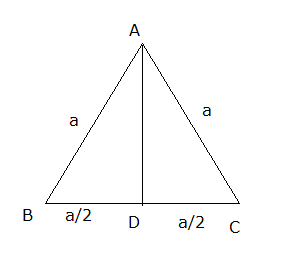
In an equilateral triangle with side $a$, prove that altitude is $\dfrac{{\sqrt 3 a}}{2}$.
Answer
568.5k+ views
Hint: We had to draw an altitude from one vertex of the equilateral to the opposite side of the equilateral triangle and then we would apply the Pythagorean Theorem on one of the two triangles formed by the altitude of the equilateral triangle.
Complete step by step answer:
As we know that the equilateral triangle is a triangle whose lengths of all the sides are equal.
So, now as we know that the altitude or height of the triangle is a line segment formed from any vertex that is perpendicular to the opposite side.
But if the triangle is equilateral then altitude also bisects the side on which it is perpendicular.
So let us draw an equilateral triangle $ABC$ in which $AD$ is altitude.

We are given that
The length of each vertex, $AB = BC = CA = a$
$AD$ is the altitude , that is $AD$ is perpendicular to $BC$
Now, in the right angled triangles $ABD$ and $ACD$, we have
\[AB = AC\]
And $AD = AD$(common side)
$\Delta ABD \cong \Delta ACD$ (By RHS congruence)
\[ \Rightarrow BD = CD\]
$ \Rightarrow BD = DC$
$ = \dfrac{1}{2}BC$
Substitute the value of $BC$ and we get,
$ = \dfrac{a}{2}$
From the right angle $ABD$
Applying Pythagorean Theorem,
$A{B^2} = A{D^2} + B{D^2}$
Apply the values and we get,
$ \Rightarrow {a^2} = A{D^2} + {\left( {\dfrac{a}{2}} \right)^2}$
Here we have to find the value of $A{D^2}$and we get
$\Rightarrow A{D^2} = {a^2} - {\left( {\dfrac{a}{2}} \right)^2}$
On squaring the bracket terms we get,
$\Rightarrow A{D^2} = {a^2} - \dfrac{{{a^2}}}{4}$
Let us take the LCM and we get,
\[\Rightarrow A{D^2} = \left( {\dfrac{{4{a^2} - {a^2}}}{4}} \right)\]
On subtracting the numerator terms we get,
$\Rightarrow A{D^2} = \dfrac{3}{4}{a^2}$
On squaring the terms we get,
$\Rightarrow AD = \dfrac{{\sqrt 3 }}{2}a$
Hence proved.
Note:
Whenever we come up with this type of problem then we should remember that the altitude of the triangle is the line segment joining the one vertex of the triangle and is perpendicular to the side opposite to it.
But if the triangle is equilateral then it also bisects the side opposite to the vertex. So here the triangle is an equilateral triangle. So, we will take $BD$ equal to $\dfrac{a}{2}$ then we will apply Pythagorean Theorem in the triangle to get the value of the altitude of the equilateral triangle.
Complete step by step answer:
As we know that the equilateral triangle is a triangle whose lengths of all the sides are equal.
So, now as we know that the altitude or height of the triangle is a line segment formed from any vertex that is perpendicular to the opposite side.
But if the triangle is equilateral then altitude also bisects the side on which it is perpendicular.
So let us draw an equilateral triangle $ABC$ in which $AD$ is altitude.

We are given that
The length of each vertex, $AB = BC = CA = a$
$AD$ is the altitude , that is $AD$ is perpendicular to $BC$
Now, in the right angled triangles $ABD$ and $ACD$, we have
\[AB = AC\]
And $AD = AD$(common side)
$\Delta ABD \cong \Delta ACD$ (By RHS congruence)
\[ \Rightarrow BD = CD\]
$ \Rightarrow BD = DC$
$ = \dfrac{1}{2}BC$
Substitute the value of $BC$ and we get,
$ = \dfrac{a}{2}$
From the right angle $ABD$
Applying Pythagorean Theorem,
$A{B^2} = A{D^2} + B{D^2}$
Apply the values and we get,
$ \Rightarrow {a^2} = A{D^2} + {\left( {\dfrac{a}{2}} \right)^2}$
Here we have to find the value of $A{D^2}$and we get
$\Rightarrow A{D^2} = {a^2} - {\left( {\dfrac{a}{2}} \right)^2}$
On squaring the bracket terms we get,
$\Rightarrow A{D^2} = {a^2} - \dfrac{{{a^2}}}{4}$
Let us take the LCM and we get,
\[\Rightarrow A{D^2} = \left( {\dfrac{{4{a^2} - {a^2}}}{4}} \right)\]
On subtracting the numerator terms we get,
$\Rightarrow A{D^2} = \dfrac{3}{4}{a^2}$
On squaring the terms we get,
$\Rightarrow AD = \dfrac{{\sqrt 3 }}{2}a$
Hence proved.
Note:
Whenever we come up with this type of problem then we should remember that the altitude of the triangle is the line segment joining the one vertex of the triangle and is perpendicular to the side opposite to it.
But if the triangle is equilateral then it also bisects the side opposite to the vertex. So here the triangle is an equilateral triangle. So, we will take $BD$ equal to $\dfrac{a}{2}$ then we will apply Pythagorean Theorem in the triangle to get the value of the altitude of the equilateral triangle.
Recently Updated Pages
Master Class 9 Social Science: Engaging Questions & Answers for Success

Master Class 9 Science: Engaging Questions & Answers for Success

Master Class 9 English: Engaging Questions & Answers for Success

Master Class 9 Maths: Engaging Questions & Answers for Success

Master Class 9 General Knowledge: Engaging Questions & Answers for Success

Class 9 Question and Answer - Your Ultimate Solutions Guide

Trending doubts
Which places in India experience sunrise first and class 9 social science CBSE

Fill the blanks with the suitable prepositions 1 The class 9 english CBSE

Write the 6 fundamental rights of India and explain in detail

Difference Between Plant Cell and Animal Cell

What is pollution? How many types of pollution? Define it

What is the Full Form of ISI and RAW




